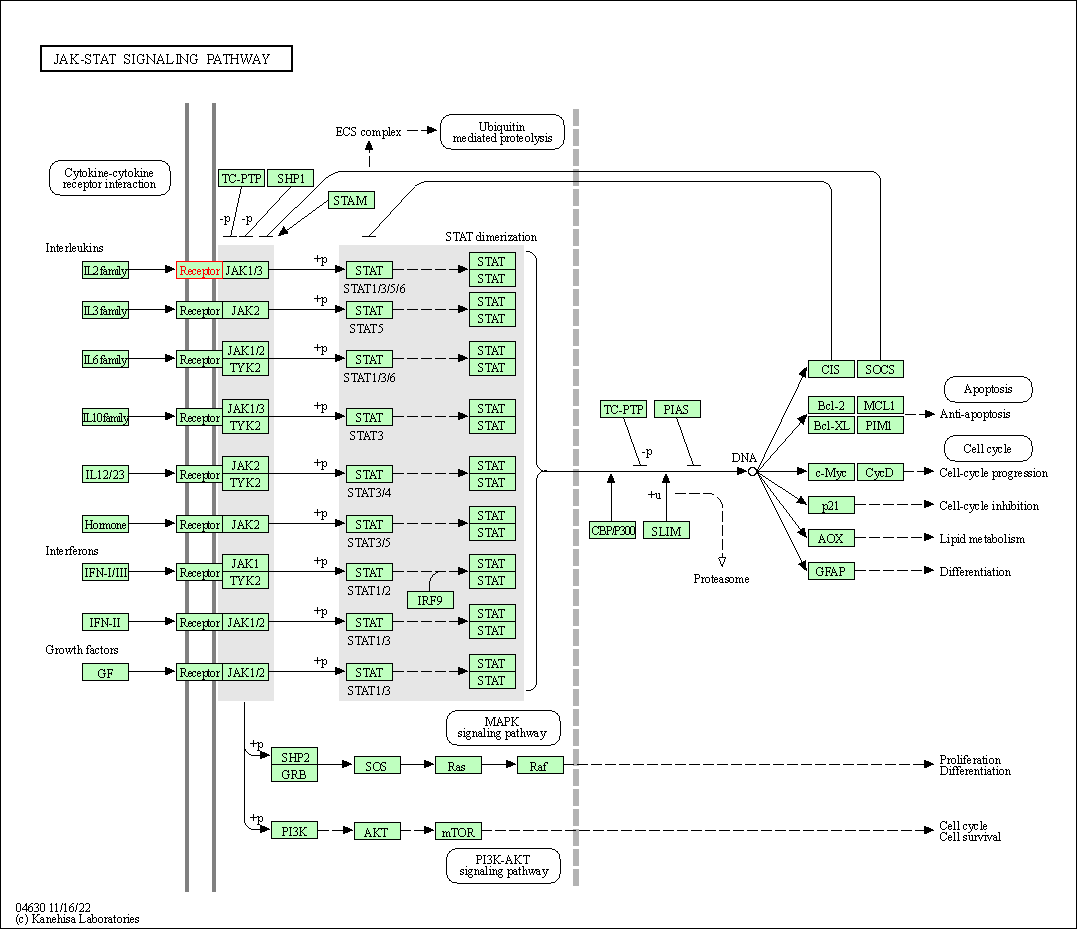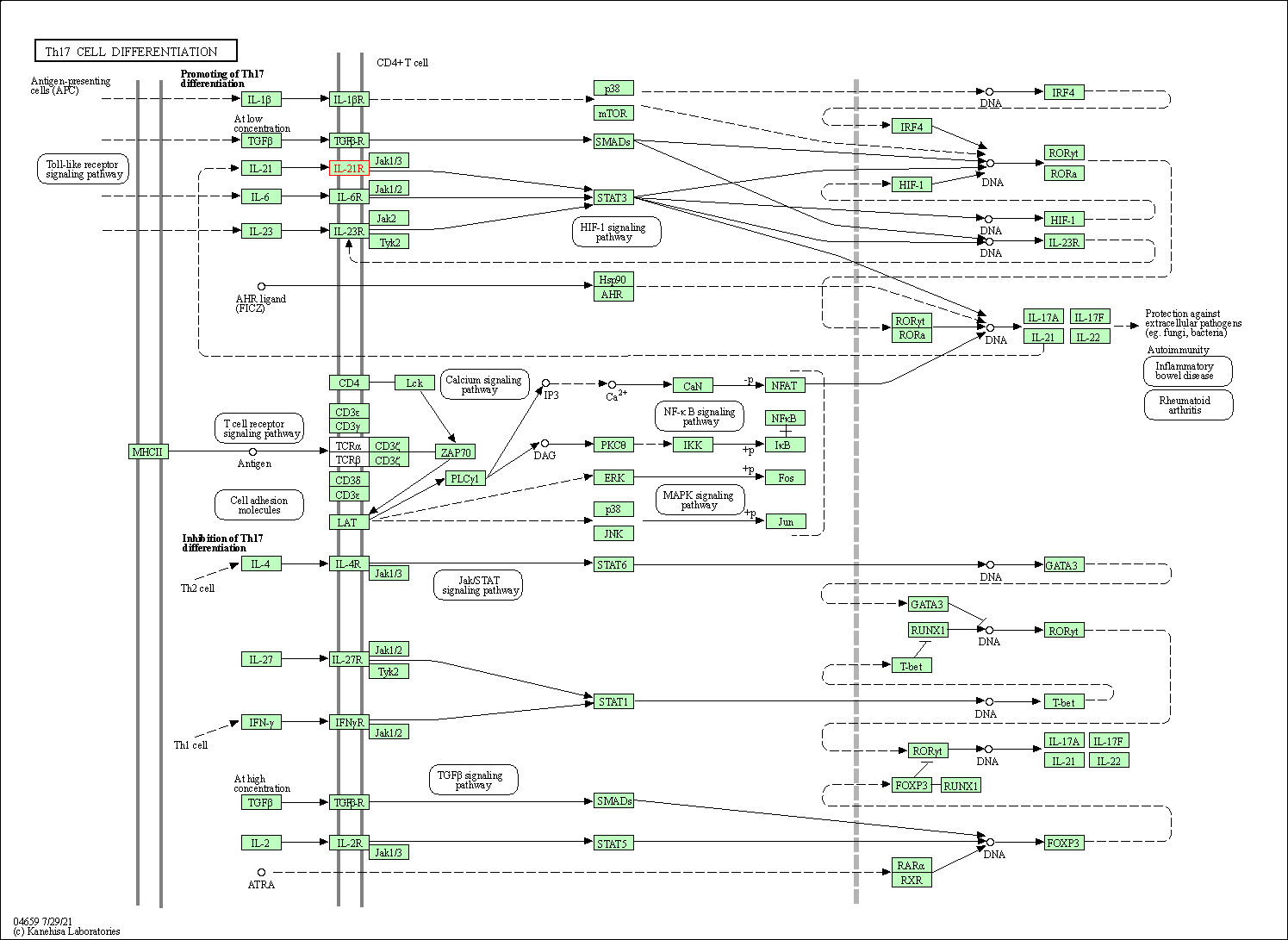Target Information
| Target General Information | Top | |||||
|---|---|---|---|---|---|---|
| Target ID |
T19334
(Former ID: TTDI02099)
|
|||||
| Target Name |
Interleukin 21 receptor (IL21R)
|
|||||
| Synonyms |
UNQ3121/PRO10273; Novel interleukin receptor; NILR; Interleukin-21 receptor; IL21 receptor; IL-21R; IL-21 receptor; CD360
Click to Show/Hide
|
|||||
| Gene Name |
IL21R
|
|||||
| Target Type |
Clinical trial target
|
[1] | ||||
| Disease | [+] 3 Target-related Diseases | + | ||||
| 1 | Postoperative inflammation [ICD-11: 1A00-CA43] | |||||
| 2 | Crohn disease [ICD-11: DD70] | |||||
| 3 | Solid tumour/cancer [ICD-11: 2A00-2F9Z] | |||||
| Function |
This is a receptor for interleukin-21.
Click to Show/Hide
|
|||||
| BioChemical Class |
Cytokine receptor
|
|||||
| UniProt ID | ||||||
| Sequence |
MPRGWAAPLLLLLLQGGWGCPDLVCYTDYLQTVICILEMWNLHPSTLTLTWQDQYEELKD
EATSCSLHRSAHNATHATYTCHMDVFHFMADDIFSVNITDQSGNYSQECGSFLLAESIKP APPFNVTVTFSGQYNISWRSDYEDPAFYMLKGKLQYELQYRNRGDPWAVSPRRKLISVDS RSVSLLPLEFRKDSSYELQVRAGPMPGSSYQGTWSEWSDPVIFQTQSEELKEGWNPHLLL LLLLVIVFIPAFWSLKTHPLWRLWKKIWAVPSPERFFMPLYKGCSGDFKKWVGAPFTGSS LELGPWSPEVPSTLEVYSCHPPRSPAKRLQLTELQEPAELVESDGVPKPSFWPTAQNSGG SAYSEERDRPYGLVSIDTVTVLDAEGPCTWPCSCEDDGYPALDLDAGLEPSPGLEDPLLD AGTTVLSCGCVSAGSPGLGGPLGSLLDRLKPPLADGEDWAGGLPWGGRSPGGVSESEAGS PLAGLDMDTFDSGFVGSDCSSPVECDFTSPGDEGPPRSYLRQWVVIPPPLSSPGPQAS Click to Show/Hide
|
|||||
| 3D Structure | Click to Show 3D Structure of This Target | AlphaFold | ||||
| Drugs and Modes of Action | Top | |||||
|---|---|---|---|---|---|---|
| Clinical Trial Drug(s) | [+] 2 Clinical Trial Drugs | + | ||||
| 1 | Ab-01 | Drug Info | Phase 2 | Inflammation | [2] | |
| 2 | ATR-107 | Drug Info | Phase 1 | Crohn disease | [4] | |
| Cell-based Target Expression Variations | Top | |||||
|---|---|---|---|---|---|---|
| Cell-based Target Expression Variations | ||||||
| Drug Binding Sites of Target | Top | |||||
|---|---|---|---|---|---|---|
| Ligand Name: Alpha-D-Mannose | Ligand Info | |||||
| Structure Description | FAB fragment complexed with C-mannosylated tryptophan peptide | PDB:6PLH | ||||
| Method | X-ray diffraction | Resolution | 1.60 Å | Mutation | No | [5] |
| PDB Sequence |
TWSEWSDP
|
|||||
|
|
||||||
| Click to View More Binding Site Information of This Target and Ligand Pair | ||||||
| Click to View More Binding Site Information of This Target with Different Ligands | ||||||
| Different Human System Profiles of Target | Top |
|---|---|
|
Human Similarity Proteins
of target is determined by comparing the sequence similarity of all human proteins with the target based on BLAST. The similarity proteins for a target are defined as the proteins with E-value < 0.005 and outside the protein families of the target.
A target that has fewer human similarity proteins outside its family is commonly regarded to possess a greater capacity to avoid undesired interactions and thus increase the possibility of finding successful drugs
(Brief Bioinform, 21: 649-662, 2020).
Human Pathway Affiliation
of target is determined by the life-essential pathways provided on KEGG database. The target-affiliated pathways were defined based on the following two criteria (a) the pathways of the studied target should be life-essential for both healthy individuals and patients, and (b) the studied target should occupy an upstream position in the pathways and therefore had the ability to regulate biological function.
Targets involved in a fewer pathways have greater likelihood to be successfully developed, while those associated with more human pathways increase the chance of undesirable interferences with other human processes
(Pharmacol Rev, 58: 259-279, 2006).
Biological Network Descriptors
of target is determined based on a human protein-protein interactions (PPI) network consisting of 9,309 proteins and 52,713 PPIs, which were with a high confidence score of ≥ 0.95 collected from STRING database.
The network properties of targets based on protein-protein interactions (PPIs) have been widely adopted for the assessment of target’s druggability. Proteins with high node degree tend to have a high impact on network function through multiple interactions, while proteins with high betweenness centrality are regarded to be central for communication in interaction networks and regulate the flow of signaling information
(Front Pharmacol, 9, 1245, 2018;
Curr Opin Struct Biol. 44:134-142, 2017).
Human Similarity Proteins
Human Pathway Affiliation
Biological Network Descriptors
|
|
| KEGG Pathway | Pathway ID | Affiliated Target | Pathway Map |
|---|---|---|---|
| Cytokine-cytokine receptor interaction | hsa04060 | Affiliated Target |

|
| Class: Environmental Information Processing => Signaling molecules and interaction | Pathway Hierarchy | ||
| JAK-STAT signaling pathway | hsa04630 | Affiliated Target |

|
| Class: Environmental Information Processing => Signal transduction | Pathway Hierarchy | ||
| Th17 cell differentiation | hsa04659 | Affiliated Target |

|
| Class: Organismal Systems => Immune system | Pathway Hierarchy | ||
| Degree | 2 | Degree centrality | 2.15E-04 | Betweenness centrality | 2.02E-04 |
|---|---|---|---|---|---|
| Closeness centrality | 1.77E-01 | Radiality | 1.29E+01 | Clustering coefficient | 0.00E+00 |
| Neighborhood connectivity | 9.50E+00 | Topological coefficient | 5.00E-01 | Eccentricity | 13 |
| Download | Click to Download the Full PPI Network of This Target | ||||
| Target Regulators | Top | |||||
|---|---|---|---|---|---|---|
| Target-regulating microRNAs | ||||||
| Target Affiliated Biological Pathways | Top | |||||
|---|---|---|---|---|---|---|
| KEGG Pathway | [+] 3 KEGG Pathways | + | ||||
| 1 | Cytokine-cytokine receptor interaction | |||||
| 2 | Jak-STAT signaling pathway | |||||
| 3 | Inflammatory bowel disease (IBD) | |||||
| NetPath Pathway | [+] 3 NetPath Pathways | + | ||||
| 1 | TCR Signaling Pathway | |||||
| 2 | IL2 Signaling Pathway | |||||
| 3 | IL5 Signaling Pathway | |||||
| References | Top | |||||
|---|---|---|---|---|---|---|
| REF 1 | URL: http://www.guidetopharmacology.org Nucleic Acids Res. 2015 Oct 12. pii: gkv1037. The IUPHAR/BPS Guide to PHARMACOLOGY in 2016: towards curated quantitative interactions between 1300 protein targets and 6000 ligands. (Target id: 2304). | |||||
| REF 2 | ClinicalTrials.gov (NCT00447837) Evaluating SPRC-AB01 in Post-Surgical Subjects With Chronic Sinusitis. U.S. National Institutes of Health. | |||||
| REF 3 | ClinicalTrials.gov (NCT04362748) Study of AMG 256 in Adult Subjects With Advanced Solid Tumors. U.S. National Institutes of Health. | |||||
| REF 4 | Anti-IL21 receptor monoclonal antibody (ATR-107): Safety, pharmacokinetics, and pharmacodynamic evaluation in healthy volunteers: a phase I, first-in-human study. J Clin Pharmacol. 2014 Jan;54(1):14-22. | |||||
| REF 5 | Yeast- and antibody-based tools for studying tryptophan C-mannosylation. Nat Chem Biol. 2021 Apr;17(4):428-437. | |||||
If You Find Any Error in Data or Bug in Web Service, Please Kindly Report It to Dr. Zhou and Dr. Zhang.

